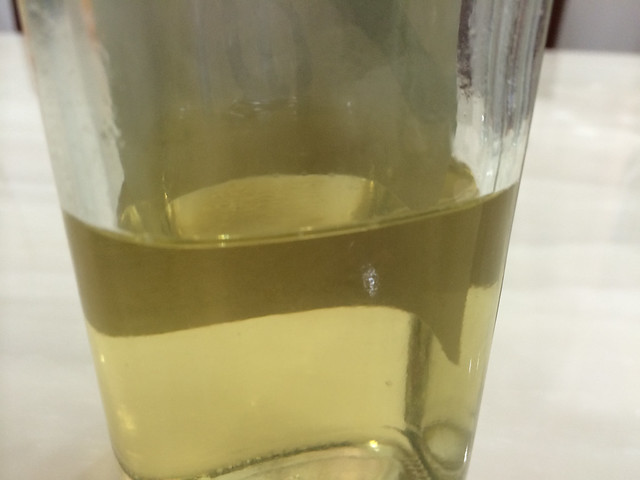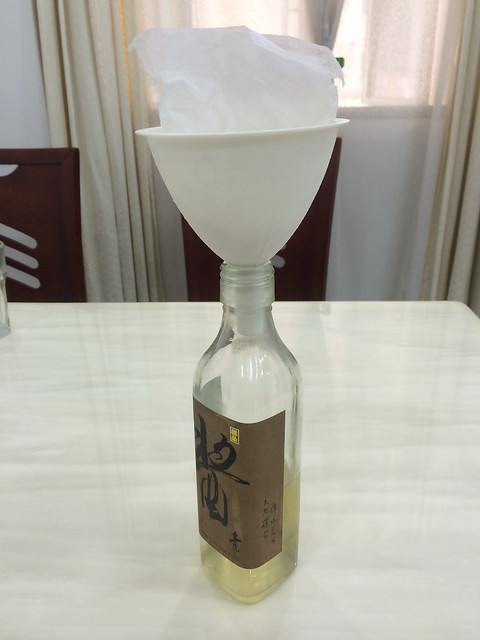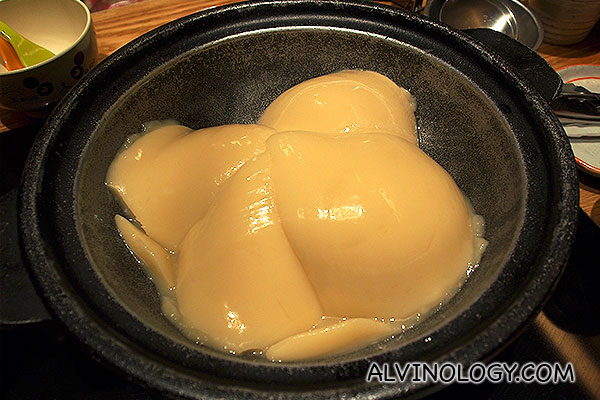懒人厨艺之 gelatin filtration 试作
Delacroix • • 63525 次浏览这次先贴成品,猜猜看是什么?

这个既不是果汁也不是花生油,是最近实验 gelatin filtration 做出来的高汤。这方法早前曾看到默识先生推荐(参见这个链接 http://www.zhihu.com/question/22008541/answer/20020312),一直觉得好奇,于是前几天就在家一试。果然汤清味鲜,而且完全不需要技术,实为懒人下厨神技。
做法和原理上一段的链接已经提到,我只写点自己的体会好了。原材料方面,我用的是猪脚和鸡架(因为当天正好想吃猪脚),鸡鸭牛羊皆可。比较便宜的就是买鸡架,FairPrice 一盒两副一块多就可以,买上四五盒完全不成问题。熬汤无需讲究,焯水之后加姜葱酒水扔进电高压锅就可不管了。如果担心胶原蛋白不够,熬出来的汤里加点吉利丁就行。冷冻时用小的制冰格,结冰和解冻都会快些。解冻时我没用纱布,而是拿泡茶用的纸包,然后放进一个漏斗,下面直接流进瓶子里,如下图所示。

解冻时有一点需要注意,水快化完时需要注意不要让胶冻也化掉了,差不多就可以收工把胶冻扔掉了,不然就白做了(我自己就是白做了一回)。曾经想当然觉得放在冷藏里化冻就可以不用看,操作了一下发现和纯粹的冰块不同,融化得非常慢,不太实际。
以前看美食纪录片介绍开水白菜,讲吊汤如何繁复,如用这个办法,则人人可做开水白菜。科学的烹调技艺,能让懒人也做出好吃的菜来。
-
#1
学习好煮意。好煮意。
-
#2
没怎么看明白是什么原理让胶质和水分开?
冰冻解冻的过程中,发生了什么?
是什么原理让胶质和水分开?
冰冻解冻的过程中,发生了什么? -
Delacroix 楼主#3
胶质和水的熔点不同低温下胶原蛋白交联成网状,吸附了使汤浑浊的大分子,而呈味物质分子不受影响。解冻时,水先于胶质融化,带走呈味物质就成了清汤。低温下胶原蛋白交联成网状,吸附了使汤浑浊的大分子,而呈味物质分子不受影响。解冻时,水先于胶质融化,带走呈味物质就成了清汤。
-
#4
学习了。。。顺便再追问一下你知道那个美人锅,里面那些胶原冻,是怎么做成的呢?你知道那个美人锅,里面那些胶原冻,是怎么做成的呢?
-
Delacroix 楼主#5
这个真不知道~我也没吃过,拿带皮的肉来熬了再冷藏也不算太麻烦吧,当然比较霸道的就是加 gelatin 或者 agar agar 了。我觉得区别也没那么大,肉汤本来也不是什么营养非常丰富的东西嘛。我也没吃过,拿带皮的肉来熬了再冷藏也不算太麻烦吧,当然比较霸道的就是加 gelatin 或者 agar agar 了。我觉得区别也没那么大,肉汤本来也不是什么营养非常丰富的东西嘛。
-
#6
没吃过可以去试试觉得味道还是不错的。。。
WestGate和PlazaSingaporua有分店。觉得味道还是不错的。。。
WestGate和PlazaSingaporua有分店。 -
#7
看了链接里面的链接外公的鸡豆花那个
用整个下午手动打发蛋白,很感人
俺在实验做湖北鱼丸鱼汆的时候,做过非常类似的东西,最大的差别大概在于有没有将蛋白打发
打算下次尝试一下外公的鸡豆花那个
用整个下午手动打发蛋白,很感人
俺在实验做湖北鱼丸鱼汆的时候,做过非常类似的东西,最大的差别大概在于有没有将蛋白打发
打算下次尝试一下 -
#8
不知道你说的胶原冻是不是皮冻?如果是的话就很好做。
猪蹄熬煮得到的汤冷却后既成。
猪皮亦可。取其豚豕皮肤中的胶原蛋白水解后的产物也。如果是的话就很好做。
猪蹄熬煮得到的汤冷却后既成。
猪皮亦可。取其豚豕皮肤中的胶原蛋白水解后的产物也。 -
#9
挺清澈的。汤熬制了多久?
-
#10
如果是鸡冻呢?
我看美人锅那里做的是鸡汤,如图:

我看美人锅那里做的是鸡汤,如图:

-
Delacroix 楼主#11
一小时不到吧~反正有电高压锅,我是能少花一点功夫是一点的。反正有电高压锅,我是能少花一点功夫是一点的。
-
#12
鸡冻也是一样,取其皮肤、脚爪和骨架熬制1小时,冷却即可得到冻状的。要得到冻,熬制汤的时候要多用皮肤、脚爪和软骨,少放肉。
猪皮冻的汤要熬制3小时,鸡取嫩鸡的部件,1个小时即可。要得到冻,熬制汤的时候要多用皮肤、脚爪和软骨,少放肉。
猪皮冻的汤要熬制3小时,鸡取嫩鸡的部件,1个小时即可。 -
#13
谢谢大神又学习了一课又学习了一课
-
#14
请教楼主,鸡架是在fairprice哪里买的?我咋从来没注意过有没有照片啊?长成什么样?有没有照片啊?长成什么样?
-
Delacroix 楼主#15
不是每一家 FairPrice 都有的吧我在 Lot One 买的,就是和鸡肉在一起的。照片此刻倒是没有,想像一下一只鸡去掉四肢内脏和身上的肉的样子就差不多。我在 Lot One 买的,就是和鸡肉在一起的。照片此刻倒是没有,想像一下一只鸡去掉四肢内脏和身上的肉的样子就差不多。
-
#16
楼主真是美食家啊。羡慕嫉妒恨!
-
Delacroix 楼主#17
楼主只是一个懒人~请诸君移步原贴链接,就会发现真正懂吃会做理论结合实践的食家。请诸君移步原贴链接,就会发现真正懂吃会做理论结合实践的食家。
-
#18
关于那个纸包怎么充当纱布用的?好神奇怎么充当纱布用的?好神奇
-
Delacroix 楼主#19
其实和袋泡茶差不多的啊~只不过我的就是空的纸包,把冰块放在里面就行,我正好有就没有另外买纱布。应该只要是能透水又不烂掉就行,比如 coffee shop 里那种泡奶茶的布袋也可以用。只不过我的就是空的纸包,把冰块放在里面就行,我正好有就没有另外买纱布。应该只要是能透水又不烂掉就行,比如 coffee shop 里那种泡奶茶的布袋也可以用。
-
#20
其实我还没完全搞明白怎么做但看起来挺健康de 但看起来挺健康de
-
#21
原来如此长知识了,谢谢长知识了,谢谢
-
Delacroix 楼主#22
我搬一个 Wikipedia 的解释好了~
原始链接参见 http://en.wikipedia.org/wiki/Consomm%C3%A9#Gelatin-filtered_.22consomm.C3.A9.22
Freezing a water-based solution converts all bulk water into ice crystals, but water associated with solutes—in the case of a soup stock, gelatin, fat, and flavor compounds—remains unfrozen to much lower temperatures; in practice, the freezing temperature of this associated water is well below the reach of conventional freezers. Thus, gelatin filtration works by freezing a gelatin-containing, water-based solution and then allowing it to thaw in a mesh strainer at just above the freezing temperature of water. The gelatin and other solutes concentrate in the unfrozen, associated water, and the gelatin forms a stable network through cross-linking, just as it would in a standard gel. This stable network acts as a filter, trapping large particles of fat or protein, while allowing water and smaller, flavor-active compounds to pass. As the bulk water melts, it passes first through the gelatin network and then through the mesh strainer, into a receiving vessel. Because the temperature is kept just above the freezing point, the bulk water melts slowly and, as it is strained into a separate vessel, it is never in contact with the gelatin for long enough to begin dissolving the gelatin network. After all of the bulk water melts, the gelatin network remains in the strainer with the trapped macroscopic particles, and the clarified stock (the bulk water and flavor compounds) is collected in the receiving vessel.
至于健康与否,一般来讲肉汤固然鲜美,营养价值却不高。即便你熬汤熬到肉烂骨酥,绝大多数营养物质还是在肉里的。
原始链接参见 http://en.wikipedia.org/wiki/Consomm%C3%A9#Gelatin-filtered_.22consomm.C3.A9.22
Freezing a water-based solution converts all bulk water into ice crystals, but water associated with solutes—in the case of a soup stock, gelatin, fat, and flavor compounds—remains unfrozen to much lower temperatures; in practice, the freezing temperature of this associated water is well below the reach of conventional freezers. Thus, gelatin filtration works by freezing a gelatin-containing, water-based solution and then allowing it to thaw in a mesh strainer at just above the freezing temperature of water. The gelatin and other solutes concentrate in the unfrozen, associated water, and the gelatin forms a stable network through cross-linking, just as it would in a standard gel. This stable network acts as a filter, trapping large particles of fat or protein, while allowing water and smaller, flavor-active compounds to pass. As the bulk water melts, it passes first through the gelatin network and then through the mesh strainer, into a receiving vessel. Because the temperature is kept just above the freezing point, the bulk water melts slowly and, as it is strained into a separate vessel, it is never in contact with the gelatin for long enough to begin dissolving the gelatin network. After all of the bulk water melts, the gelatin network remains in the strainer with the trapped macroscopic particles, and the clarified stock (the bulk water and flavor compounds) is collected in the receiving vessel.
至于健康与否,一般来讲肉汤固然鲜美,营养价值却不高。即便你熬汤熬到肉烂骨酥,绝大多数营养物质还是在肉里的。